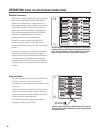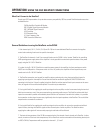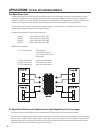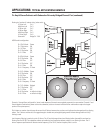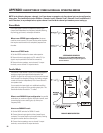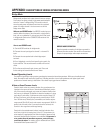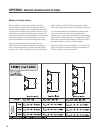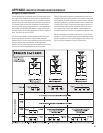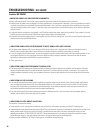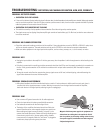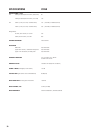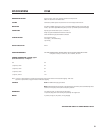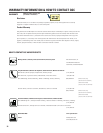
28
•
INDICATION:
CLIP LED FLASHING
• If the red clip indicator flashes when signal is applied, the amplifier output may be shorted. Check that the speaker cable connec-
tions are tight and reliable at both ends. Check the speaker cables for stray strands or breaks in the insulation. Trim off all loose
strands of wire and insulate any exposed wire with electrical tape. All connections should be made with great care and all wire
terminations should be carefully checked to ensure quality workmanship.
• If the red clip indicator flashes when connecting the speaker cable between the + and - terminals, then that speaker cable (or
speaker) may be shorted. Check the cable and the speaker.
TROUBLESHOOTING: NO SOUND
Problem:
NO SOUND
• INDICATION:
POWER LED INDICATOR NOT ILLUMINATED
• Check both ends of the AC line cord for proper connection. Both ends should be fully seated in their connectors.
• Check that the AC outlet works by plugging in a known-good device or by testing with a voltmeter. If too many amplifiers are used on
one outlet, the building's circuit breaker may trip and shut off power. If this is the case, unplug some of the amplifiers from the outlet,
reset the building’s breaker and try again. For the other amps, use an outlet that is connected to another circuit breaker to distribute
the load current.
• If using the DataPort connections, the channel 1 and 2 DataPort controls the power supply of the amplifier. Check whether or not the
DataPort accessory connected to the CX168 is forcing the power supply into standby mode.
• An amplifier which keeps tripping the AC circuit breaker may have a serious internal fault. Turn it off, remove AC power, and have the
amplifier serviced by a qualified technician.
•
INDICATION:
SIGNAL LED’S NOT RESPONDING TO INPUT SIGNAL LEVEL (NOT LIGHTING)
• If the green power
indicator LED is lit, but the signal LEDs do not light up at all, check the input. Make sure the signal source is
working and try another input cable. Connect the source to another channel or amplifier to check that it is working.
• If you are using the terminal block inputs, be sure the connectors are fully inserted at both ends of all interconnecting cables. If you
are using the DataPort for your input signal, ensure the DataPort cable is properly connected at both ends and that the device
supplying the audio signal to the DataPort is properly configured.
• Check gain controls.
•
INDICATION:
SIGNAL LEDS RESPONDING TO SIGNAL LEVEL
• If the green signal LED indicators are lighting normally, the fault is somewhere between the amplifier and the speakers. Check the
speaker wiring for breaks. Check for proper connection at each end. Try another speaker and cable, if necessary. If your system has
multiple speakers connected in series, any one speaker failure will cause all other speakers (in the same series circuit) to lose their
signal.
•
INDICATION:
CLIP LEDS BRIGHT AND STEADY
The amplifier is in protective muting.
• Three seconds or so of muting is normal when the amp is turned on. After power-up muting, the Clip LED‘s should go out.
• Overheating will cause protective muting and the Clip LED to fully illuminate. If the amp is overheated, the fan will be running at full
speed and the chassis will be very warm to the touch; sound should resume within a minute as the amplifier cools to a safe
operating temperature. DO NOT TURN THE AMP OFF! This would stop the fan from cooling the inside of the amplifier. Instead,
reduce the input signal ( or amp gain setting) and wait for the amp to resume operation automatically.
• Check for proper ventilation. If the fan isn't running at all, the amplifier requires servicing.



